1997 CHEVROLET CORVETTE weight
[x] Cancel search: weightPage 4 of 356
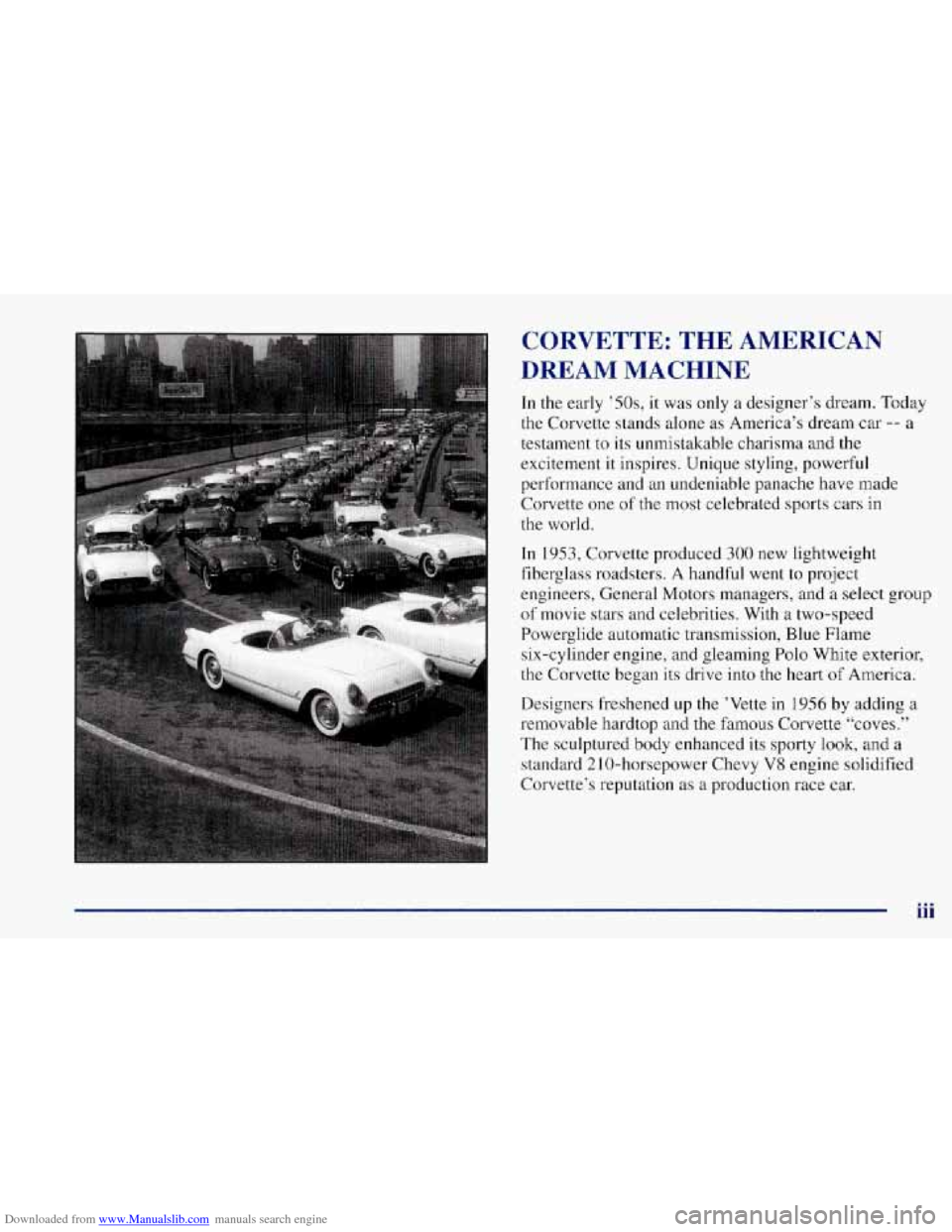
Downloaded from www.Manualslib.com manuals search engine CORVETTE: THE AMERICAN
DREAM MACHINE
In the early ’50s, it was only a designer’s dream. Today
the Corvette stands alone
as America’s dream car -- a
testament
to its unmistakable charisma and the
excitement
it inspires. Unique styling, powerful
performance and an undeniable panache have made
Corvette one
of the most celebrated sports cars in
the world.
In 1953, Corvette produced 300 new lightweight
fiberglass roadsters.
A handful went to project
engineers, General Motors managers, and a select group
of movie stars and celebrities. With a two-speed
Powerglide automatic transmission, Blue Flame
six-cylinder engine, and gleaming Polo White exterior,
the Corvette began its drive into the heart of America.
Designers freshened up the ’Vette in
1956 by adding a
removable hardtop and the famous Corvette “coves.”
The sculptured body enhanced its sporty
look, and a
standard 210-horsepower Chevy V8 engine solidified
Corvette’s reputation as a production race car.
ii i
Page 84 of 356
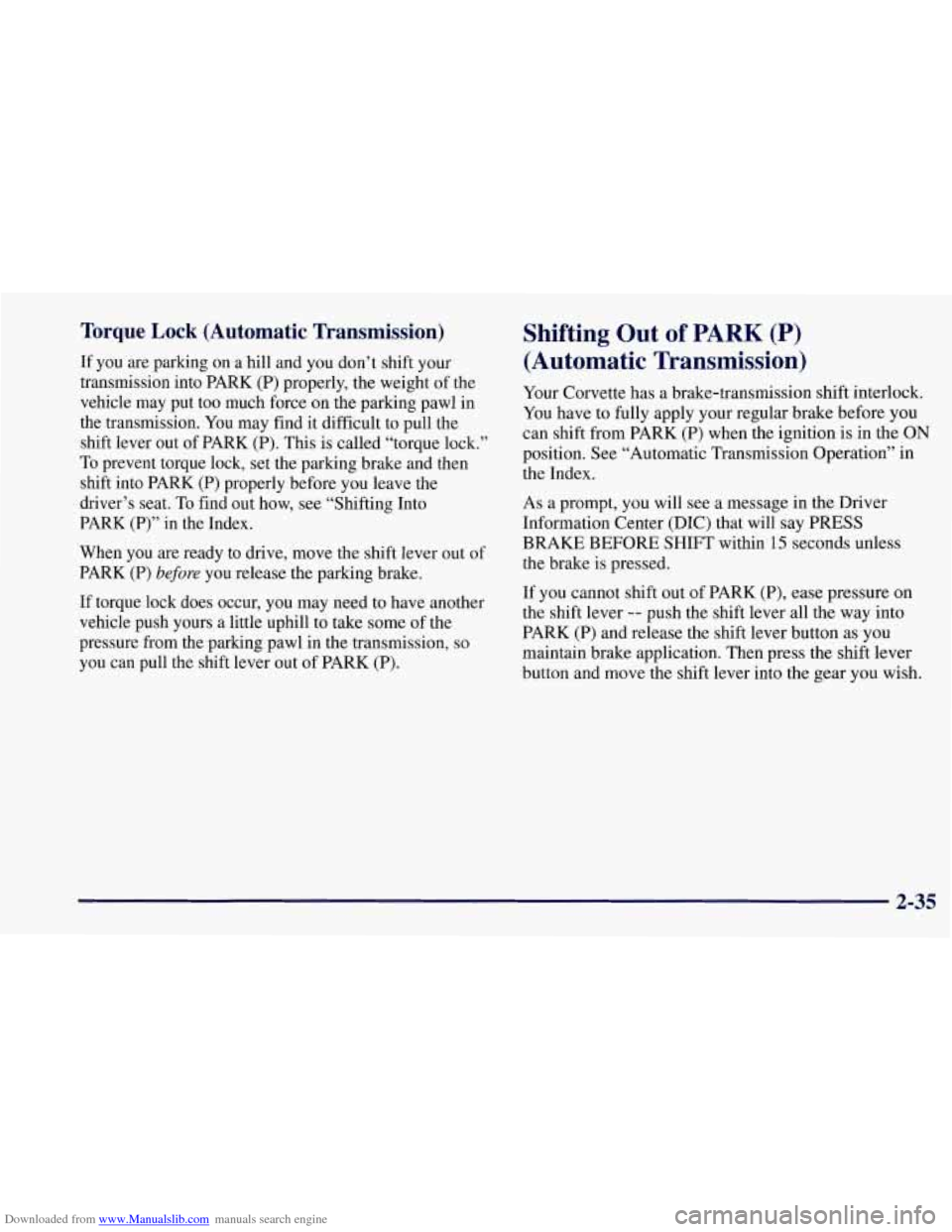
Downloaded from www.Manualslib.com manuals search engine Torque Lock (Automatic Transmission)
If you are parking on a hill and you don’t shift your
transmission into PARK (P) properly, the weight of the
vehicle may put too much force on the parking pawl in
the transmission. You may find it difficult to pull the
shift lever out of PARK (P). This is called “torque lock.”
To prevent torque lock, set the parking brake and then
shift into PARK (P) properly before you leave the
driver’s seat.
To find out how, see “Shifting Into
PARK (P)” in the Index.
When you are ready to drive, move the shift lever out of
PARK (P)
before you release the parking brake.
If torque lock does occur, you may need to have another
vehicle push yours a little uphill to take some of the
pressure from the parking pawl in the transmission, so
you can pull the shift lever out of PARK
(P).
Shifting Out of PARK (P)
(Automatic Transmission)
Your Corvette has a brake-transmission shift interlock.
You have to fully apply your regular brake before you
can shift from PARK (P) when the ignition is in the
ON
position. See “Automatic Transmission Operation” in
the Index.
As a prompt, you will see a message in the Driver
Information Center (DIC) that will say PRESS
BRAKE BEFORE SHIFT within
15 seconds unless
the brake is pressed.
If you cannot shift out of PARK (P), ease pressure on
the shift lever
-- push the shift lever all the way into
PARK (P) and release the shift lever button
as you
maintain brake application. Then press the shift lever
button and move the shift lever into the gear you wish.
2-35
Page 182 of 356
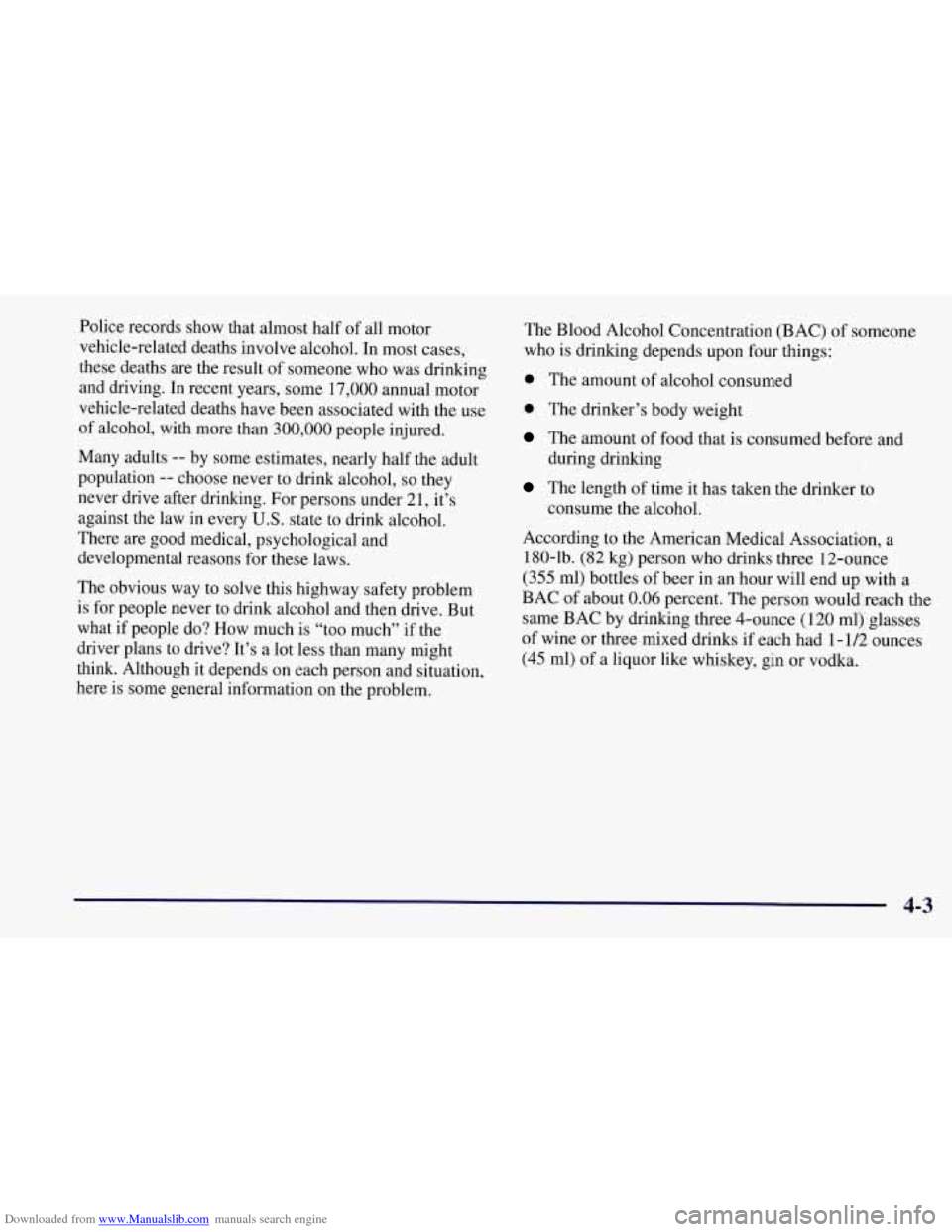
Downloaded from www.Manualslib.com manuals search engine Police records show, that almost half of all motor
vehicle-related deaths involve alcohol. In most cases,
these deaths
are the result of someone who was drinking
and driving. In recent years, some 17,000 annual motor
vehicle-related deaths have been associated with the use
of alcohol, with more than
300,000 people injured.
Many adults
-- by some estimates, nearly half the adult
population
-- choose never to drink alcohol, so they
never drive after drinking. For persons under 21, it’s
against the law
in every U.S. state to drink alcohol.
There are good medical, psychological and
developmental reasons for these laws.
The obvious way to solve this highway safety problem
is for people never to drink alcohol and then drive. But
what
if people do? How much is “too much” if the
driver plans to drive? It’s a lot less than many might
think. Although it depends on each person and situation,
here is some general information on the problem. The Blood Alcohol Concentration (BAC)
of someone
who is drinking depends upon four things:
0 The amount of alcohol consumed
0 The drinker’s body weight
The amount of food that is consumed before and
during drinking
The length of time it has taken the drinker to
consume the alcohol.
According to the American Medical Association, a
180-lb. (82 kg) person who drinks three 12-ounce
(355 ml) bottles of beer in an hour will end up with a
BAC of about
0.06 percent. The person would reach the
same BAC by drinking three 4-ounce
(1 20 ml) glasses
of wine or three mixed drinks if each had 1-1/2 ounces
(45 ml) of a liquor like whiskey, gin
or vodka.
4-3
Page 183 of 356
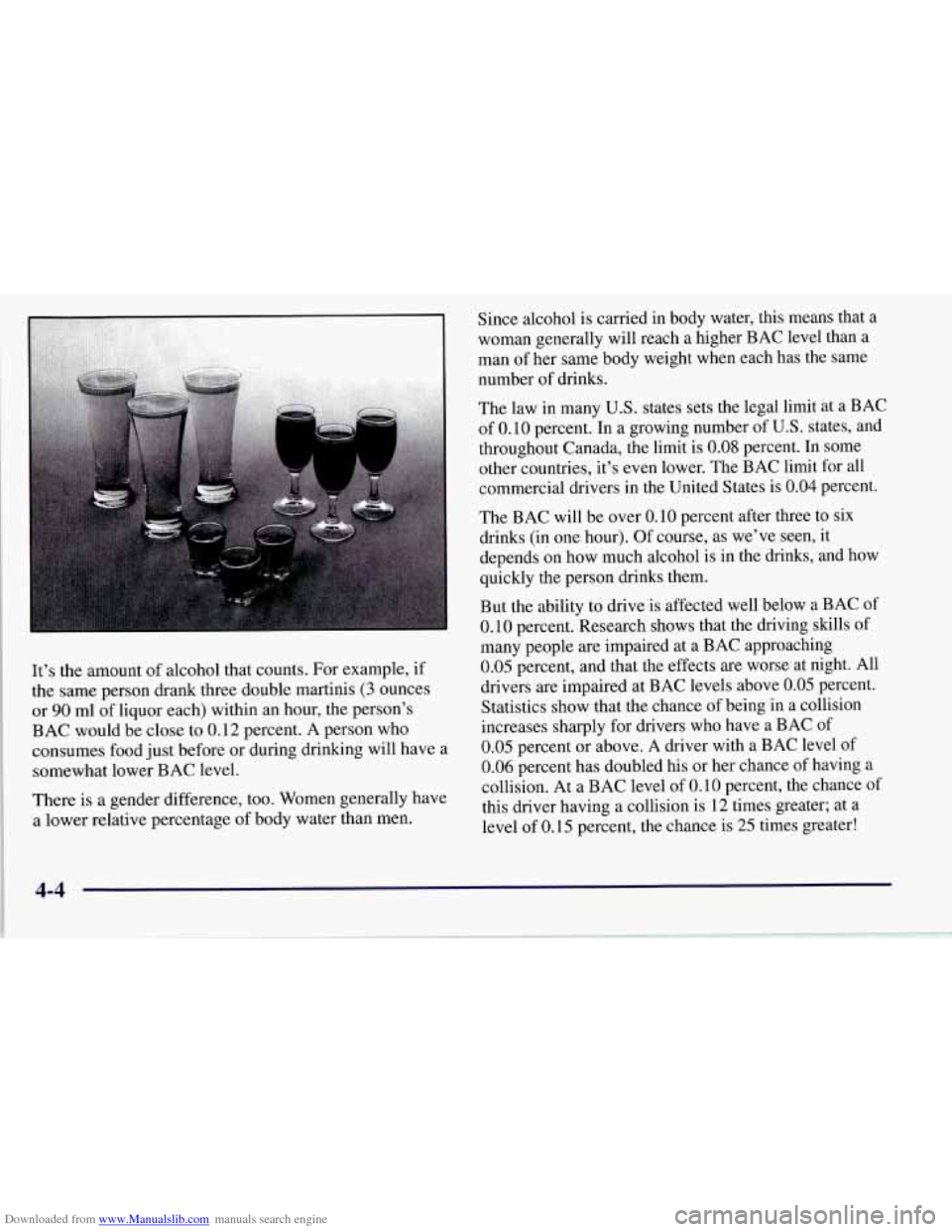
Downloaded from www.Manualslib.com manuals search engine It’s the amount of alcohol that counts. For example, if
the same person drank
three double martinis (3 ounces
or
90 ml of liquor each) within an hour, the person’s
BAC would be close to 0.12 percent. A person who
consumes food just before or during drinking will have a
somewhat lower BAC level.
There
is a gender difference, too. Women generally have
a lower relative percentage of body water than men. Since
alcohol is carried in body water, this means that a
woman generally will reach a higher BAC level than a
man
of her same body weight when each has the same
number
of drinks.
The law in many
U.S. states sets the legal limit at a BAC
of
0.10 percent. In a growing number of U.S. states, and
throughout Canada, the limit is
0.08 percent. In some
other countries, it’s even lower. The BAC limit for all
commercial drivers in the United States
is 0.04 percent.
The BAC will be over
0.10 percent after three to six
drinks (in one hour).
Of course, as we’ve seen, it
depends on how much alcohol is in the drinks, and how
quickly the person drinks them.
But the ability to drive is affected well below a BAC
of
0.10 percent. Research shows that the driving skills of
many people are impaired at a BAC approaching
0.05 percent, and that the effects are worse at night. All
drivers are impaired at BAC levels above
0.05 percent.
Statistics show that the chance of being in a collision
increases sharply for drivers who have a BAC of
0.05 percent or above. A driver with a BAC level of
0.06 percent has doubled his or her chance of having a
collision. At a BAC level
of 0.10 percent, the chance of
this driver having a collision is 12 times greater; at a
level of 0.15 percent, the chance is
25 times greater!
4-4
Page 185 of 356
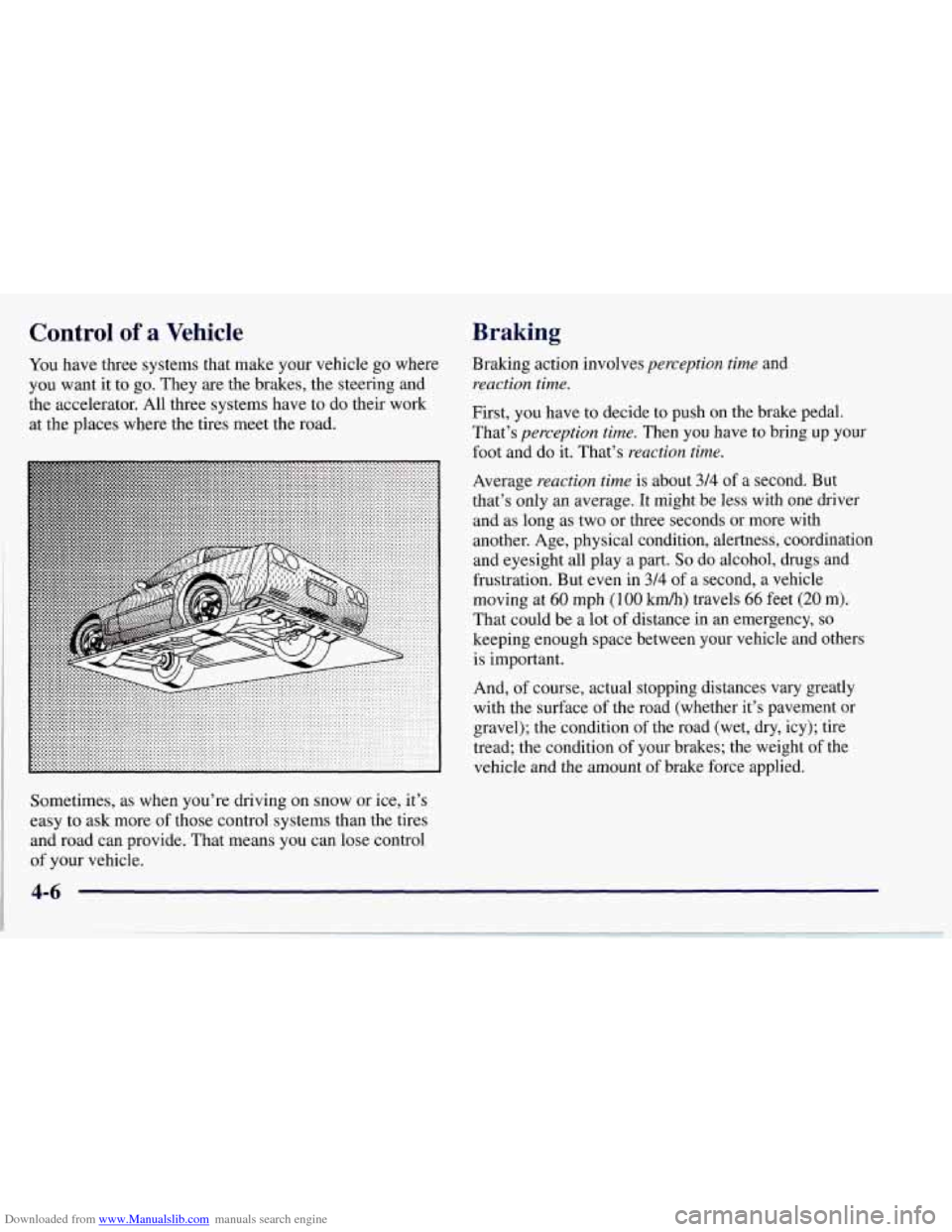
Downloaded from www.Manualslib.com manuals search engine Control of a Vehicle
You have three systems that make your vehicle go where
you want it to go. They
are the brakes, the steering and
the accelerator. All three systems have to do their work
at the places where the tires meet the road.
Braking
Braking action involves perception time and
reaction time.
First, you have to decide to push on the brake pedal.
That’s
perception time. Then you have to bring up your
foot and do it. That’s
reaction time.
Average reaction time is about 314 of a second. But
that’s only an average. It might
be less with one driver
and as long as two or three seconds or more with
another. Age, physical condition, alertness, coordination and eyesight all play a part.
So do alcohol, drugs and
frustration. But even in 3/4
of a second, a vehicle
moving at
60 mph (100 km/h) travels 66 feet (20 m).
That could be a lot of distance in an emergency, so
keeping enough space between your vehicle and others
is important.
And,
of course, actual stopping distances vary greatly
with the surface
of the road (whether it’s pavement or
gravel); the condition of the road (wet, dry, icy); tire
tread; the condition of your brakes; the weight
of the
vehicle and the amount of brake force applied.
Sometimes, as when you’re driving
on snow or ice, it’s
easy to ask more
of those control systems than the tires
and road can provide. That means you can lose control
of your vehicle.
4-6
Page 209 of 356
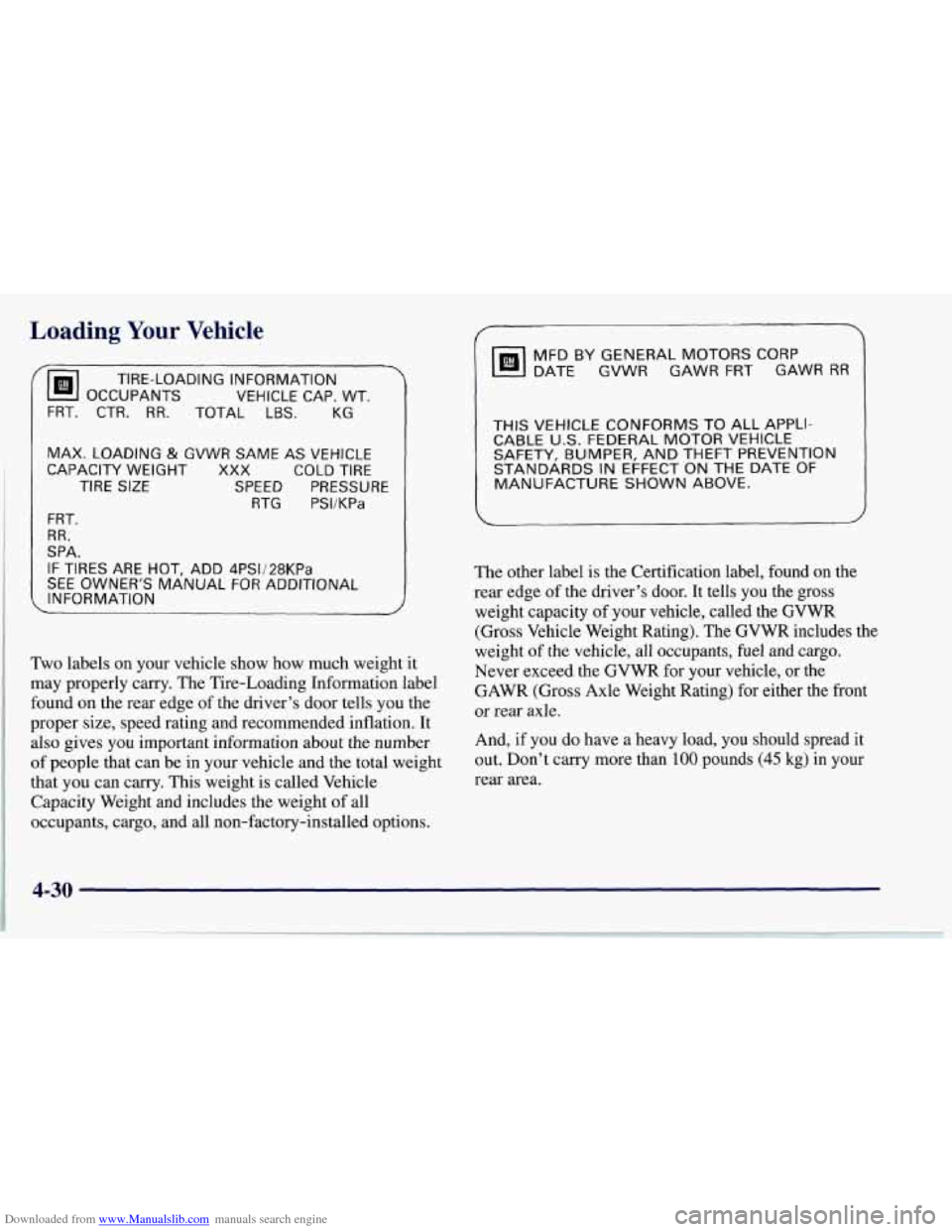
Downloaded from www.Manualslib.com manuals search engine Loading Your Vehicle
/ -
OCCUPANTS VEHICLE CAP. WT.
TIRE-LOADING INFORMATION
FRT. CTR.
RR. TOTAL LBS. KG
MAX.
LOADING & GVWR SAME AS VEHICLE
CAPACITY WEIGHT
XXX COLD TIRE
TIRE SIZE SPEED PRESSURE
RTG
PSI/KPa
FRT. RR.
SPA. IF
TIRES ARE HOT, ADD 4PS1/28KPa
SEE OWNER’S MANUAL FOR ADDITIONAL
INFORMATION
Two labels on your vehicle show how much weight it
may properly carry. The Tire-Loading Information label
found on the rear edge of the driver’s door tells you the
proper size, speed rating and recommended inflation. It
also gives you important information about the number
of people that can be in your vehicle and the total weight
that you can carry. This weight is called Vehicle
Capacity Weight and includes the weight of all
occupants, cargo, and all non-factory-installed options.
DATE GVWR GAWR FRT GAWR RR
MFD BY GENERAL MOTORS CORP
THIS VEHICLE CONFORMS TO ALL APPLI-
CABLE U.S. FEDERAL MOTOR VEHICLE
SAFETY, BUMPER, AND THEFT PREVENTION
STANDARDS
IN EFFECT ON THE DATE OF
MANUFACTURE SHOWN ABOVE.
The other label is the Certification label, found on the
rear edge of the driver’s door. It tells you
the gross
weight capacity of your vehicle, called the GVWR
(Gross Vehicle Weight Rating).
The GVWR includes the
weight
of the vehicle, all occupants, fuel and cargo.
Never exceed the GVWR for your vehicle, or the
GAWR (Gross Axle Weight Rating) for either the front
or rear axle.
And,
if you do have a heavy load, you should spread it
out. Don’t carry more than
100 pounds (45 kg) in your
rear area.
4-30
Page 210 of 356

Downloaded from www.Manualslib.com manuals search engine ' A CA"T1ON:
-
Do not load your vehicle any heavier than the
GVWR, or either the maximum front or rear
GAWR. If you do, parts on your vehicle can
break, or
it can change the way your vehicle
handles. These could cause you to lose control.
Also, overloading can shorten the life of
your vehicle.
NOTICE:
Your warranty does not cover parts or
components that fail because of overloading.
~~ ~ ~ ~ ~~ ~ ~~~ ~ ~~ ~
If you put things inside your vehicle -- like suitcases,
tools, packages or anything else
-- they will go as fast as
the vehicle goes.
If you have to stop or turn quickly, or
if there is a crash, they'll keep going.
__ --_I ,
Things you put inside your vehicle can strike
and injure people in a sudden stop or turn,
or in
a crash.
0 Put things in the rear area of your vehicle.
Try to spread the weight evenly.
0 Never stack heavier things, like suitcases,
inside the vehicle
so that some of them are
above the tops
of the seats.
0 Don't leave an unsecured child restraint in
your vehicle.
0 When you carry something inside the
vehicle, secure
it whenever you can.
Towing A Trailer
Your Corvette is neither designed nor intended to tow
a trailer.
4-31
Page 348 of 356

Downloaded from www.Manualslib.com manuals search engine Fiberglass Springs .............................. 6-58
Fifth Gear. Manual Transmission
................... 2-29
Filling Your Tank
................................ 6-5
Filter. Air Cleaner
.............................. 6- 16
Finish Care
.................................... 6-56
Finish Damage
................................. 6-57
First Gear. Automatic Transmission
................ 2-28
First Gear. Manual Transmission
................... 2-29
Flashers. Hazard Warning
......................... 5-2
Flat Tire. What to
Do ............................ 5-22
Floor Mats
.................................... 2-60
Fluid Capacities
................................ 6-70
FobTraining
................................... 2-89
Foreign Countries, Fuel
........................... 6-5
Fourth Gear. Manual Transmission
................. 2-29
French Language Manual
11
Front Sidemarker Lamp Bulb Replacement ........... 6-35
Front Turn Signal Lamp Bulb Replacement
.......... 6-35
Fuel
.......................................... 6-3
Canada
...................................... 6-4
In Foreign Countries
........................... 6-5
Fuel. Filling Your Tank
........................... 6-5
Fuses and Circuit Breakers
....................... 6-63
Gages
FogLamps
.................................... 2-51
.. ...........................
FrontTowing .................................. 5-10
Gage ....................................... 2-80
Engine Coolant Temperature
.................... 2-75
Engine Oil Pressure
........................... 2-78
Fuel
....................................... 2-81
Voltmeter
................................... 2-73 GAWR
.................................. 4.30. 4.31
Gear Positions
................................. 2-26
Gross Axle Weight Rating
................... 4.30. 4.31
Gross Vehicle Weight Rating
................. 4.30. 4-31
Guide en Franpis
11
GVWR .................................. 4.30. 4.31
Halogen Bulbs
................................ 6-33
Hazard Warning Flashers
.......................... 5-2
Headlamp Doors
............................... 2-44
Headlamp/Highbeams Bulb Replacement
............ 6-33
Headlamps
.................................... 2-43
Wiring
..........................................
Hearing Impaired, Customer Assistance .............. 8-4
Heating
....................................... 3-12
High-Beam Lamps
.............................. 2-45
Highway Hypnosis
............ ............... 4-24
Hill and Mountain Roads
..... ............. 4-24
Hood
Checking Things Under
...... .............. 6-8
Release
.................................... 6-8
Horn
......................................... 2-40
Hydraulic Clutch
............................... 6-20
Hydroplaning
.......................... ... 4-20
.. .................................
HighLow Beamchanger ...................... 2-45
Heritage Pages
111 ... ...................................
Ignition Switch .............. ............... 2-20
Inadvertent Load Control
....... ............... 2-53
Inflation. Tire
.................................. 6-43
Inside Daymight Rearview Mirror
................. 2-53
9-5